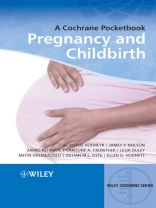Pregnancy and Childbirth presents the best evidence for the
care of pregnant women to doctors, midwives, students and
parents. The logical sequence of chapters and the index give
quick access to the abstracts of over four hundred Cochrane
systematic reviews. The book serves both as a stand-alone
reference, and as a companion to locating full reviews on the
Cochrane Library.
The Cochrane Library is published by John Wiley on behalf of The
Cochrane Collaboration.
href=’http://www.thecochranelibrary.com/’>www.thecochranelibrary.com
Cuprins
Foreword.
Preface.
How to use this book.
What is evidence?
The Cochrane Pregnancy and Childbirth Group.
Scope of this book.
Methods for the Cochrane Pregnancy and Childbirth.
Group reviews.
Abridgement of the Cochrane Pregnancy and Childbirth abstracts
in this book.
Systematic review protocols.
Effectiveness icons.
How to locate the original review.
A brief guide to the format of results in Cochrane
reviews.
Acknowledgements.
Authors.
Chapter 1. The Context of Care for Pregnant
Women.
Chapter 2. Antenatal Care.
2.1 Pre-pregnancy evaluation.
2.2 General antenatal care.
2.3 Behaviour/advice during pregnancy.
2.4 Nutrition during pregnancy.
2.5 Weight gain in pregnancy.
2.6 Symptoms during pregnancy.
2.7 Use of medicines during pregnancy.
2.8 Miscarriage.
Chapter 3. Medical Problems During Pregnancy.
3.1 Hypertension during pregnancy.
3.2 Anaemia during pregnancy.
3.3 Diabetes mellitus.
3.4 Thrombocytopenia.
3.5 Inherited coagulation defects.
3.6 Thrombophilias.
3.7 Haemoglobinopathies.
3.8 Thromboembolic disease.
3.9 Myasthenia Gravis.
3.10 Cardiac disease.
3.11 Renal disease.
3.12 Epilepsy.
3.13 Human immunodeficiency virus infection (HIV).
3.14 Other viral infections.
3.15 Malaria.
3.16 Other infections.
3.17 Respiratory illness.
3.18 Liver disease.
3.19 Thyroid disease.
3.20 Haemorrhoids.
3.21 Psychiatric disorders.
3.22 Skin diseases.
Chapter 4. Disorders Affecting the Unborn Baby.
4.1 Routine assessment of the baby during pregnancy.
4.2 Prenatal diagnosis.
4.3 Impaired growth and wellbeing of the unborn baby.
4.4 Blood group incompatibilities – prevention and
treatment.
4.5 Death of the unborn baby.
Chapter 5. Pregnancy Complications.
5.1 Prelabour rupture of membranes.
5.2 Preterm birth.
5.3 Prolonged pregnancy.
5.4 Multiple pregnancy.
5.5 Antepartum haemorrhage.
5.6 Infection during pregnancy.
Chapter 6. Induction of Labour.
6.1 Specific indications for labour induction.
6.2 Techniques of labour induction – primary reviews.
6.3 Techniques of labour induction – secondary
reviews.
Chapter 7. Care During Childbirth.
7.1 Place of birth.
7.2 Routine care during labour.
7.3 Pain during labour.
7.4 Slow progress during labour.
7.5 Shoulder dystocia.
7.6 Abnormal presentations and positions of the baby.
7.7 Babies with compromised condition during labour .
7.8 Cord prolapse.
7.9 Perineal trauma.
7.10 Operative vaginal birth.
7.11 Caesarean section.
7.12 Pregnancy following caesarean section.
7.13 Extrauterine pregnancy.
7.14 Postpartum haemorrhage and retained placenta.
7.15 Inversion of the uterus.
Chapter 8. Care After Childbirth.
8.1 Basic care of mother and baby.
8.2 Perineal pain.
8.3 Family planning.
8.4 Perinatal death.
8.5 Medical conditions after childbirth.
8.6 Unhappiness after childbirth.
8.7 Breastfeeding.
Chapter 9. Rogues’ Gallery.
Index.
Despre autor
Professor G. Justus Hofmeyr
Director/Hon Professor, Effective Care Research Unit, University of the Witwatersrand, University of Fort Hare, Eastern Cape Department of Health, Frere and Cecilia Makiwane Hospitals, South Africa.
Prof Zarko Alfirevic
Professor of Fetal and Maternal Medicine Division of Perinatal and Reproductive Medicine, The University of Liverpool, UK.
Caroline A. Crowther
Associate Professor, Dept Obstetrics and Gynaecology, University of Adelaide, South Africa.
Lelia Duley
Obstetric Epidemiologist, Institute of Health Sciences, Oxford, UK.
Dr A Metin Gülmezoglu
Department of Reproductive Health and Research, World Health Organization.
Mrs Gillian? ML Gyte
Cochrane Pregnancy and Childbirth Group, Division of Perinatal and Reproductive Medicine, The University of Liverpool, UK.
Ellen D. Hodnett
Professor James P. Neilson, Obstetrics and Gynaecology, University of Liverpool, UK.












